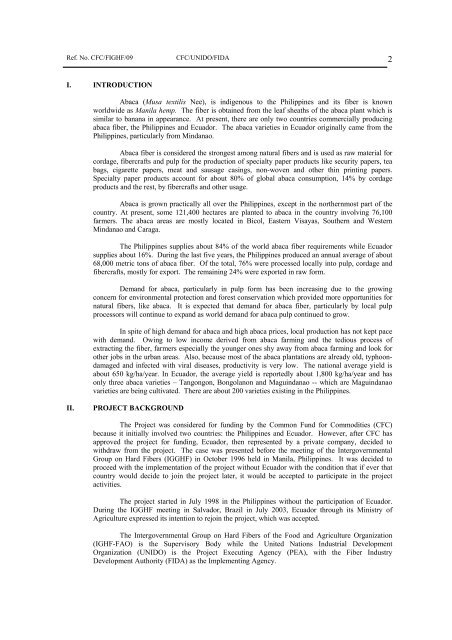ABACA Activities in the Philippines - Unido
ABACA Activities in the Philippines - Unido
ABACA Activities in the Philippines - Unido
You also want an ePaper? Increase the reach of your titles
YUMPU automatically turns print PDFs into web optimized ePapers that Google loves.
Ref. No. CFC/FIGHF/09 CFC/UNIDO/FIDA 2<br />
I. INTRODUCTION<br />
Abaca (Musa textilis Nee), is <strong>in</strong>digenous to <strong>the</strong> Philipp<strong>in</strong>es and its fiber is known<br />
worldwide as Manila hemp. The fiber is obta<strong>in</strong>ed from <strong>the</strong> leaf sheaths of <strong>the</strong> abaca plant which is<br />
similar to banana <strong>in</strong> appearance. At present, <strong>the</strong>re are only two countries commercially produc<strong>in</strong>g<br />
abaca fiber, <strong>the</strong> Philipp<strong>in</strong>es and Ecuador. The abaca varieties <strong>in</strong> Ecuador orig<strong>in</strong>ally came from <strong>the</strong><br />
Philipp<strong>in</strong>es, particularly from M<strong>in</strong>danao.<br />
Abaca fiber is considered <strong>the</strong> strongest among natural fibers and is used as raw material for<br />
cordage, fibercrafts and pulp for <strong>the</strong> production of specialty paper products like security papers, tea<br />
bags, cigarette papers, meat and sausage cas<strong>in</strong>gs, non-woven and o<strong>the</strong>r th<strong>in</strong> pr<strong>in</strong>t<strong>in</strong>g papers.<br />
Specialty paper products account for about 80% of global abaca consumption, 14% by cordage<br />
products and <strong>the</strong> rest, by fibercrafts and o<strong>the</strong>r usage.<br />
Abaca is grown practically all over <strong>the</strong> Philipp<strong>in</strong>es, except <strong>in</strong> <strong>the</strong> nor<strong>the</strong>rnmost part of <strong>the</strong><br />
country. At present, some 121,400 hectares are planted to abaca <strong>in</strong> <strong>the</strong> country <strong>in</strong>volv<strong>in</strong>g 76,100<br />
farmers. The abaca areas are mostly located <strong>in</strong> Bicol, Eastern Visayas, Sou<strong>the</strong>rn and Western<br />
M<strong>in</strong>danao and Caraga.<br />
The Philipp<strong>in</strong>es supplies about 84% of <strong>the</strong> world abaca fiber requirements while Ecuador<br />
supplies about 16%. Dur<strong>in</strong>g <strong>the</strong> last five years, <strong>the</strong> Philipp<strong>in</strong>es produced an annual average of about<br />
68,000 metric tons of abaca fiber. Of <strong>the</strong> total, 76% were processed locally <strong>in</strong>to pulp, cordage and<br />
fibercrafts, mostly for export. The rema<strong>in</strong><strong>in</strong>g 24% were exported <strong>in</strong> raw form.<br />
Demand for abaca, particularly <strong>in</strong> pulp form has been <strong>in</strong>creas<strong>in</strong>g due to <strong>the</strong> grow<strong>in</strong>g<br />
concern for environmental protection and forest conservation which provided more opportunities for<br />
natural fibers, like abaca. It is expected that demand for abaca fiber, particularly by local pulp<br />
processors will cont<strong>in</strong>ue to expand as world demand for abaca pulp cont<strong>in</strong>ued to grow.<br />
In spite of high demand for abaca and high abaca prices, local production has not kept pace<br />
with demand. Ow<strong>in</strong>g to low <strong>in</strong>come derived from abaca farm<strong>in</strong>g and <strong>the</strong> tedious process of<br />
extract<strong>in</strong>g <strong>the</strong> fiber, farmers especially <strong>the</strong> younger ones shy away from abaca farm<strong>in</strong>g and look for<br />
o<strong>the</strong>r jobs <strong>in</strong> <strong>the</strong> urban areas. Also, because most of <strong>the</strong> abaca plantations are already old, typhoondamaged<br />
and <strong>in</strong>fected with viral diseases, productivity is very low. The national average yield is<br />
about 650 kg/ha/year. In Ecuador, <strong>the</strong> average yield is reportedly about 1,800 kg/ha/year and has<br />
only three abaca varieties – Tangongon, Bongolanon and Magu<strong>in</strong>danao -- which are Magu<strong>in</strong>danao<br />
varieties are be<strong>in</strong>g cultivated. There are about 200 varieties exist<strong>in</strong>g <strong>in</strong> <strong>the</strong> Philipp<strong>in</strong>es.<br />
II.<br />
PROJECT BACKGROUND<br />
The Project was considered for fund<strong>in</strong>g by <strong>the</strong> Common Fund for Commodities (CFC)<br />
because it <strong>in</strong>itially <strong>in</strong>volved two countries: <strong>the</strong> Philipp<strong>in</strong>es and Ecuador. However, after CFC has<br />
approved <strong>the</strong> project for fund<strong>in</strong>g, Ecuador, <strong>the</strong>n represented by a private company, decided to<br />
withdraw from <strong>the</strong> project. The case was presented before <strong>the</strong> meet<strong>in</strong>g of <strong>the</strong> Intergovernmental<br />
Group on Hard Fibers (IGGHF) <strong>in</strong> October 1996 held <strong>in</strong> Manila, Philipp<strong>in</strong>es. It was decided to<br />
proceed with <strong>the</strong> implementation of <strong>the</strong> project without Ecuador with <strong>the</strong> condition that if ever that<br />
country would decide to jo<strong>in</strong> <strong>the</strong> project later, it would be accepted to participate <strong>in</strong> <strong>the</strong> project<br />
activities.<br />
The project started <strong>in</strong> July 1998 <strong>in</strong> <strong>the</strong> Philipp<strong>in</strong>es without <strong>the</strong> participation of Ecuador.<br />
Dur<strong>in</strong>g <strong>the</strong> IGGHF meet<strong>in</strong>g <strong>in</strong> Salvador, Brazil <strong>in</strong> July 2003, Ecuador through its M<strong>in</strong>istry of<br />
Agriculture expressed its <strong>in</strong>tention to rejo<strong>in</strong> <strong>the</strong> project, which was accepted.<br />
The Intergovernmental Group on Hard Fibers of <strong>the</strong> Food and Agriculture Organization<br />
(IGHF-FAO) is <strong>the</strong> Supervisory Body while <strong>the</strong> United Nations Industrial Development<br />
Organization (UNIDO) is <strong>the</strong> Project Execut<strong>in</strong>g Agency (PEA), with <strong>the</strong> Fiber Industry<br />
Development Authority (FIDA) as <strong>the</strong> Implement<strong>in</strong>g Agency.

















